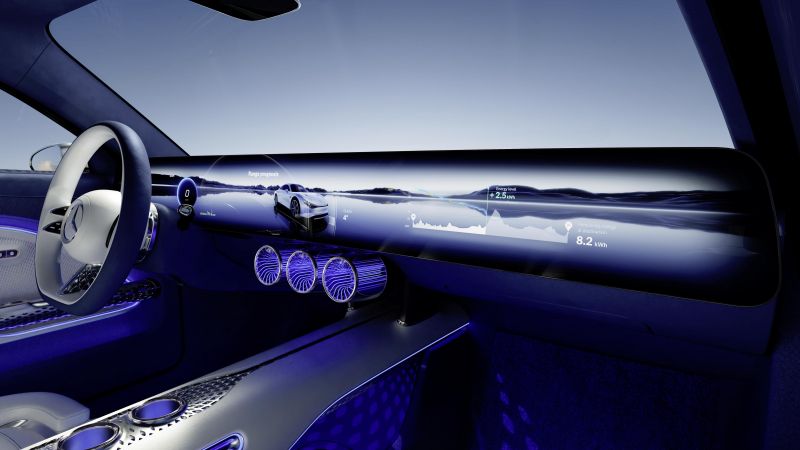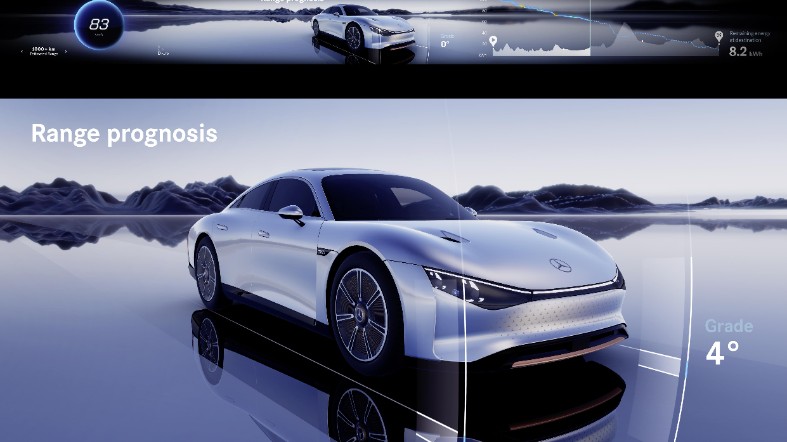Mercedes-Benz is Partnering with Game Engine Developer Unity Technologies to Create Immersive, 3D Infotainment Screens and Displays for its Future Vehicles
【Summary】San Francisco-based game engine developer Unity, which is widely recognized for its immersive 3D graphics for the video game industry, announced a new partnership with automaker Mercedes Benz. As part of the partnership, Unity’s 3D game engine will be used to power the infotainment screens on all future software-based vehicles running the automaker's new Mercedes-Benz Operating system dubbed “MB.OS”.

San Francisco-based game engine developer Unity Technologies, which is widely recognized for its immersive 3D graphics for the video game industry, announced a new partnership with automaker Mercedes Benz.
As part of the partnership, Unity's 3D technology will be used to power the infotainment screens on all future software-based Mercedes-Benz vehicles running the automaker's new Mercedes-Benz Operating system dubbed "MB.OS".
MB.OS will link vehicle vehicles with the cloud and the Internet of Things (IoT) and include four central vehicle domains: Powertrain, Autonomous Driving, Infotainment, and Body/Comfort Systems.
The first Mercedes-Benz vehicles using Unity's real-time 3D gaming engine will debut in 2024. The automaker selected Unity after a rigorous, comprehensive evaluation process which included competing real-time 3D and HMI development solutions.
The 3D visuals provided by Unity will be like "nothing ever seen before in the auto industry", according to the company.
Unity's real-time 3D engine, which first launched in 2005, will deliver intuitive and visually engaging experiences, including from 3D avatars that will serve ad digital assistants, 3D maps for improving navigation, augmented reality (AR)-enhanced experiences, as well as AI-powered software that adjusts vehicle settings and behaviors by learning user habits and preferences.
Mercedes-Benz shared a preview of what customers can expect from the Unity-powered infotainment system with the unveiling of the Vision EQXX electric sedan concept in April. The Vision EQXX features a 47.5-inch wide 3D display that stretches across the entire dashboard.
After working closely with Unity to build innovative real-time 3D experiences in its research prototype vehicles like the EQXX, Mercedes-Benz plans to lead the industry in the development of vehicle software by partnering with Unity on future projects. Eventually the 3D infotainment system will expand to all Mercedes-Benz product lines.

Mercedes-Benz developers will use the "Unity Industrial Collection" to create the UI/UX for the entire digital cockpit, including the instrument cluster and media and passenger displays. Unity's
3D product visualization software bundle includes everything automakers need to visualize data in real-time 3D, including augmented and virtual reality technologies.
Unity enables a "what you see is what you get" (WYSIWYG) software development environment. It will aid Mercedes-Benz's HMI design group in creating visually compelling, highly interactive concepts and designs. Thanks to the WYSIWYG design environment, the Mercedes-Benz design group will know exactly how their visuals will appear and perform in production vehicles beforehand.
It will be a big step forward from the traditional human-machine interface (HMI) toolchains in the auto industry to build 2D infotainment systems that are simply not capable of delivering such a high level of cutting-edge, 3D visual experiences.
Future Mercedes-Benz vehicles will be software-defined and capable of receiving regular over the air software updates. It will allow the company to offer customers larger, more immersive dashboard displays, but also redefine how drivers and passengers interact with the software in their vehicles.
Eventually, every Mercedes-Benz model globally will come with the advanced and upgradable software-based architecture, from the entry-level A-Class to S-Class models, according to the company.
Back in 2019, Mercedes-Benz Group Chief Design Officer Gorden Wagener said that "screens are the new horsepower" in the auto industry.
Like most automakers. Mercedes-Benz is investing billions in electrification, software development, autonomous driving, connected vehicle technology and digital services. An important step towards that goal will be the company's new "Electric Software Hub" at the Mercedes Technology Center in Sindelfingen, Germany, which officially opened in April.
The location, which announced last year, will employ around 1,100 cross-functional teams, including software, hardware, system integration and testing functions will be located under one roof to help create the electric and digital future of Mercedes-Benz.
The Electric Software Hub is intended to help accelerate the automaker's transformation as part of its strategic plan to "lead in electric drive and car software".
The Electric Software Hub brings together the two key strategic topics for the future of Mercedes-Benz. The new site will serve as a central software development and qualification hub to ensure everything works correctly.

Future Mercedes-Benz vehicles will feature rich, 3D displays and infortainment systems.
In March 2021, Unity announced a separate partnership with mapping company HERE Technologies to create 3D maps for navigation. 3D maps for navigation represent another example of the next-generation of in-vehicle human machine interfaces (HMI's).
HERE Technologies is a leading provider of map content and location-based services to the global automotive industry. The company is owned by a consortium of German automakers, including Mercedes-Benz, BMW and Audi, as well as Tier-1 auto industry suppliers Bosch and Continental.
The collaboration will combine automotive-grade map data with an advanced real-time 3D engine to offer a more dynamic automotive user-experience.
Using 3D maps for navigation can help drivers to better orient themselves, offering a detailed view of their surroundings and an easier way to visualize turn-by-turn driving directions while offering a more immersive experience for accessing in-vehicle infotainment options.
In addition to its real-time 3D engine, Unity also operates an industry leading platform for creating and operating real-time 3D applications. The platform is widely used by architects, filmmakers and automotive designers.
-


Ford is Testing a New Robotic Charging Station to Assist Drivers of EVs With Disabilities
-


Ford Raises the Prices of the F-150 Lightning Electric Pickup Due to Rising Raw Material Costs
-


The BMW 7-Series to Feature HD Live Maps From HERE Technologies for Hands-Free Highway Driving in North America at Speeds up to 80 MPH
-


AutoX to Use the 'Eyeonic Vision Sensor' from California-based SiLC Technologies for its Robotaxi Fleet in China
-


LG Develops ‘Invisible’ Speaker Sound Technology That Could Revolutionize In-Vehicle Audio
-


Researchers at South Korea’s Chung-Ang University Develop a ‘Meta-Reinforcement’ Machine Learning Algorithm for Traffic Lights to Improve Vehicle Throughput
-


Zeekr’s New 009 Electric Passenger Van is the World’s First EV to Feature CATL’s Advanced ‘Qilin’ Battery With a Range of 510 Miles
-


Redwood Materials is Building an Electric Vehicle Battery Recycling Facility in South Carolina
- Volkswagen Group China Unveils its ‘Flying Tiger’ Electric Vertical Take-Off and Landing (eVTOL) Passenger Aircraft Prototype
- Mercedes-Benz Signs MoU With the Government of Canada to Source the Raw Materials for Electric Vehicle Batteries
- Volvo’s Electric Vehicle Brand Polestar Reports $1 Billion in Revenue in the First Half of 2022, Adds 6 New Global Markets
- General Motors Launches ‘EV Live’ an Interactive Virtual Experience Where Participants Can Learn More About Electric Vehicles
- Munro and Associates Offers a Detailed Look of How the Front Seats of the Tesla Model Y Are Bolted to its Battery in New Video
- China's Tech Giant Baidu Plans to Rollout the World’s Largest Fully Autonomous Ride-Hailing Service by Next Year
- Mercedes-Benz is Partnering with Game Engine Developer Unity Technologies to Create Immersive, 3D Infotainment Screens and Displays for its Future Vehicles
- Electric Hypercar Developer Rimac Raises $500 Million Euro in Series D Round, Investors Include Porsche, Softbank and Goldman Sachs
- Toyota is Investing an Additional $2.5 Billion to Expand its North Carolina Factory to Boost EV Battery Production
- Apple Reveals the Next-Gen Version of CarPlay, Which Takes Over a Vehicle’s Entire Dashboard and Screens











 About Us
About Us Contact Us
Contact Us Careers
Careers